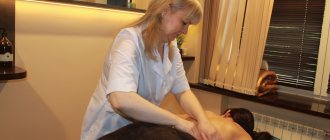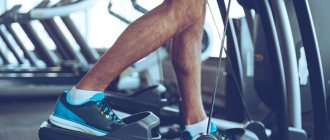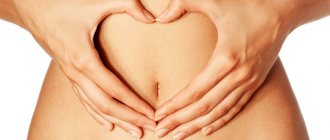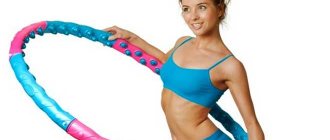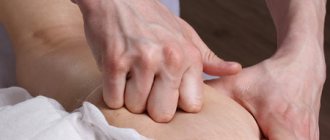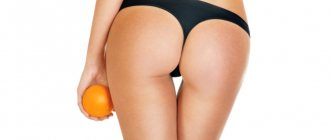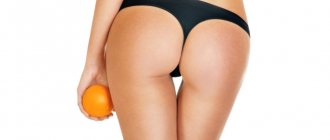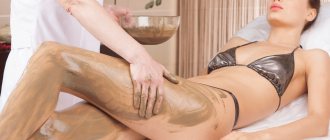Lymphatic drainage massage is a “spring cleaning” and detox for the body. Together with lymph, harmful substances, excess water, and decay products are removed from our body. A sedentary lifestyle interferes with the movement of lymph due to compression of blood vessels. The intercellular space is filled with toxins, a feeling of fatigue appears, the body's protective functions are weakened, and metabolism is disrupted. A course of lymphatic drainage massage restores tone and energy, strengthens the immune system, and helps to become slimmer.
What is lymph and why is it important?
Lymph is a clear, yellowish liquid that is a type of connective tissue in the body. It flows through the lymphatic system from bottom to top, from the tips of the fingers and toes to the thoracic lymphatic duct.
Lymph returns proteins, water, salts, toxins, and metabolites from tissues to the blood for elimination. Lymphatic fluid is involved in the formation of immunity, protection from germs and viruses, and recovery from intoxication. Lymph is also released on fresh wounds and abrasions. The lymphocytes it contains protect the damaged area from infections.
Lymphatic drainage massage accelerates the movement of lymph throughout the body. The liquid begins to circulate faster, removing waste products from the intercellular space.
Who is this type of massage suitable for?
Lymphatic drainage massage is perfect for anyone who has no contraindications. It can be used as an independent way to correct your figure and get rid of cellulite. Or as one of the components of an integrated approach: this way it will be even easier and more effective to lose extra pounds and centimeters.
Lymphatic drainage is effective for women and men at any age. Taking the course is especially relevant if:
- You constantly feel lethargic and tired, often get sick, suffer from insomnia or regularly face stress. Lymphatic drainage has a beneficial effect on the psycho-emotional state and strengthens the immune system.
- You notice swelling on your body, “bags” have appeared under your eyes. Hands and feet swell even after prolonged sitting or, for example, sleep. This may be evidence of malfunctioning of the lymphatic system.
- You have noticed changes in the structure of your skin: acne or unwanted pigmentation has suddenly appeared.
- You dream of losing weight and tightening your figure, restoring elasticity to your skin.
- You have noticed age-related changes - swelling, loss of elasticity and tone, changes in the oval of the face.
- If you are recovering from an injury or surgery, lymphatic drainage will speed up regeneration and shorten the rehabilitation period.
- You regularly engage in strength sports. Massage is a great way to recover after hard training.
Main indications for the procedure
A course of lymphatic drainage massage is prescribed for the following conditions:
- Constant lethargy, increased fatigue.
- Frequent lingering colds.
- Pain throughout the body.
- Excess weight, cellulite, decreased skin turgor.
- Varicose veins, poor circulation of the extremities.
- Insomnia.
- Postoperative scars, stretch marks.
- Swelling, appearance of dark circles under the eyes.
- Acne, acne, papillomas, age spots.
Lymphatic drainage massage of the body stimulates the movement of lymph from the organs to the central lymphatic vessels that flow into the thoracic lymphatic duct and the inferior vena cava. The accumulated liquid is mechanically pushed through, breaking the stagnation. Lymph begins to circulate freely, saturating body tissues with oxygen and nutrients.
Indications for drainage massage for weight loss
Lymphatic drainage massage is used in the following cases:
- increased body weight with signs of fluid retention in the body;
- heaviness in the legs, increased hip circumference due to lymphatic stagnation;
- external signs of cellulite.
During such exposure, the removal of harmful substances from tissues is activated, their blood supply improves, and immune defense is enhanced.
Lymphatic drainage massage sessions are also indicated for patients recovering from injuries, burns, and cicatricial changes in the skin.
This technique is used to rejuvenate the skin and improve its appearance, eliminate the “double chin,” and correct the contours of the face and neck. It is especially effective for the appearance of morning puffiness under the eyes - a sign of fluid stagnation in the tissues.
How are lymphatic drainage massage procedures performed?
The physiotherapeutic procedure is painless and lasts about an hour. The session consists of three stages:
- Preparation. At this stage you need to relax your body. For greater effectiveness, before the massage the patient needs to drink up to 1 liter of warm, clean water. Before starting the procedure, the massage therapist applies cream or oil to the patient’s skin, then begins to work on the lines along which the lymph nodes are located. If a special device is used, the specialist preheats the soft tissues with his hands.
- Impact on lymph nodes. Lymphatic vessels are more fragile than blood vessels and require a careful approach. The specialist’s movements should be smooth, soft, and wave-like. All massage techniques are performed strictly along the lines of lymph flow in the direction of the lymph nodes.
- Completion. After finishing the lymphatic drainage massage, you can dry yourself with a towel to remove any remaining cream from the body. The patient needs to rest for about 10 minutes before leaving the couch. A sudden rise can cause dizziness.
In order for massage sessions to bring maximum benefit, the course of treatment is supplemented with light lymphatic drainage exercises, it is recommended to drink enough clean water and eat right. Body mobility stimulates the lymphatic system, helps fluid circulate faster, oxygenating tissues with nutrients.
Manual massage
Wanting to achieve a certain result for a problem area, massage of different depths is used. In this regard, a distinction is made between superficial, deep and targeted effects.
- The surface effect consists
from very light massage movements performed strictly in the direction of lymph flow - from top to bottom or from the center to the periphery. As a result, metabolic processes in the skin improve due to a positive effect on small vessels and improved blood flow in them. The techniques of such a massage are easy to learn on your own and perform the procedure at home.
- Deep impact stimulates
muscle layers of tissue due to a more intense effect on the patient’s body. The positive effect of this procedure is the acceleration of lymph flow, the removal of excess fluid and toxins, the reduction of swelling, increased muscle tone, oxygen saturation of tissues, and a decrease in the volume of the buttocks and hips.
- Point impact represents
are local manipulations in the area of projections of the main lymph nodes. Only a specialist can perform such a massage.
Main areas of influence
During the procedure, the specialist moves along a trajectory from the wrist to the armpit, from the neck to the armpits, from the abdomen to the groin, from the foot to the groin.
The masseur begins with a massage of the subclavian area, smoothly moving to the groin area through the solar plexus and abdomen. This is followed by lymphatic drainage massage of the back and lumbar region. Afterwards the area of the collarbones, elbows and armpits is worked on. Each massage movement is repeated at least five times.
During a lymphatic drainage facial massage, a specialist massages areas near the ears, forehead, under the jaw, and near the sinuses. Movements in the facial area are performed gently and carefully so as not to damage the skin.
Indications
- Slowing metabolism;
- Excess weight;
- Edema;
- Cellulite;
- Flabbiness of the skin, loss of tone;
- Slow skin regeneration;
- Severe stretch marks and scars resulting from injuries;
- The initial stage of varicose veins;
- Decreased skin elasticity;
- Drooping (ptosis) of facial tissues;
- Poor psycho-emotional state;
- Lymphostasis;
- Postoperative recovery and rehabilitation after injuries;
- Weak immunity.
Lymphatic drainage massage techniques
Lymphatic drainage massage techniques are divided into three categories according to intensity:
- Superficial lymphatic drainage massage for small vessels. The massage therapist preheats the soft tissues, preparing them for more intense effects. Then, with light circular movements, it works on all areas, facilitating the movement of lymph.
- Deep effect on muscle tissue. More intense and in-depth massage techniques stimulate blood circulation, increase muscle tone, dilate blood vessels, which helps lymph circulate freely through the intercellular spaces. This technique reduces body volume and improves skin condition.
- Point effect on the projections of the lymph nodes. This is a technique for performing hardware effects using microcurrents, pressotherapy or LPG massage.
Each lymphatic drainage massage technique has a targeted effect on the lymph flow. Depending on the problem areas of the patient’s body, the following techniques are used:
- Lymphatic drainage massage for swelling and poor circulation. The masseur makes rhythmic but smooth movements, stroking, working in depth on the muscle tissue in the neck, back and legs. Indications for performing lymphatic drainage massage using this technique: cellulite, swelling, varicose veins.
- Anti-cellulite technique for “orange peel” and hypertrophy of fat deposits. The lymphatic drainage body massage procedure is performed locally in problem areas. Relaxation of muscles and tissues helps to loosen fatty tissue and remove excess fluid. By improving blood circulation, the skin tightens, becomes smoother and more elastic.
- Lipolytic technique for reducing subcutaneous fat. This technique eliminates local body defects, for example, “ears” on the hips. The massage therapist smoothly moves from gentle to intense effects aimed at the correction area.
- Modeling lymphatic drainage technique for figure correction. The intensity of the massage is selected individually for each patient. No painful techniques are used during the session. All movements of the specialist are soft, smooth, promoting better lymph circulation.
- A lifting technique for restoring skin tone after childbirth, surgery or sudden weight loss. The lymphatic drainage effect enhances tissue regeneration, accelerates metabolism, and stimulates the natural production of collagen.
Manual and hardware massage techniques complement each other. Manual treatment is suitable for sensitive areas of the body; the equipment helps to effectively work the legs and lumbar region.
Physiological action
In the human body, the lymphatic system serves to remove excess fluid that has entered the intercellular space from cells or vessels. Its physiological role is not limited to this: when the functioning of the lymphatic capillaries is disrupted, vague pain and heaviness in the limbs, weakness, fatigue, and a tendency to allergic reactions and colds appear.
The effect of massage on lymphatic vessels
These formations create a kind of mesh that covers every centimeter of skin and surrounds every internal organ. More than 70% of the smallest lymphatic vessels are located in the skin. Therefore, drainage massage for weight loss is aimed specifically at improving the outflow of intercellular fluid through them.
Up to 3 liters of fluid are drained through the lymphatic system per day. It contains protein and retains water due to increased oncotic pressure. Lymph also includes dead cells, waste products, microorganisms, inorganic substances, and fats. During lymphatic drainage sessions, all these harmful products are actively removed from the tissues.
When lymphatic drainage massage is performed correctly, the flow of fluid from tissues increases 20 times. However, if the impact on the vessels is too intense and at the same time they are compressed by tissues, they are easily deformed and stop draining fluid. Therefore, this procedure is not performed in areas of edema.
Liquid from the capillaries is collected in larger vessels, which have valves on the inner walls. These folds of the inner lining of the vessel are designed in such a way that they do not allow lymph to flow in the opposite direction. When performing lymphatic drainage, you do not need to apply too much effort. Otherwise, the pressure inside the vessel may increase, its lumen will expand, and the valves will become ineffective. As a result, lymph will begin to penetrate towards the periphery, back into the tissue. If there is no deep pressure, lymphatic drainage massage is safe.
The walls of large lymphatic vessels are capable of contracting in waves. In this case, a kind of chain reaction occurs, accompanied by increased lymphatic drainage through other vessels, which has a beneficial effect on the condition of the body. The movement of lymph is helped by skeletal muscles, the suction action of the chest during inhalation, and the pulsation of the arteries. Therefore, physical activity is always accompanied by an improvement in the functioning of the lymphatic system.
Effect on lymph nodes
All lymph through the vessels enters the lymph nodes, of which there are about 500 in the body. They are mainly concentrated in the abdominal cavity, and there are many of them in the tissues of the neck.
Lymph nodes filter fluid, obstructing the flow of lymph. Drainage massage accelerates this process, activating the cleansing of the blood from microorganisms and their antigens.
Eliminating lymph stagnation
Each cell receives nutrients, including proteins, as they pass from the blood capillaries through the intercellular space. Metabolic products are also sent in the opposite direction with the help of proteins. Both inside the blood capillary and in the interstitial space there should be approximately equal amounts of proteins. If they accumulate in tissues, water from the capillaries begins to linger between the cells and causes swelling. Sometimes they do not appear externally, but are accompanied by a noticeable increase in body weight.
Preventing such edema is one of the tasks of the lymphatic system. When lymph nodes are removed or vascular contractility is weak, stagnation of tissue fluid begins. To eliminate it, lymphatic drainage massage is useful.
If the cause of edema is liver, kidney, heart disease, diabetes and other therapeutic problems, then the lymphatic drainage effect will not have a positive effect.
Recommendations before and after the procedure
To benefit from lymphatic drainage massage, follow these recommendations:
- During the entire course, do not drink alcohol, it is advisable to quit smoking;
- do not drink a lot of liquid in the evening;
- conduct massage sessions in the afternoon, a few hours after lunch or dinner;
- Before the session, take a shower and monitor the condition of your skin.
Immediately after the procedure it is recommended:
- lie on the couch for about 10 minutes, rise from it smoothly;
- drink up to 500 ml of warm clean water;
- make a lymphatic drainage wrap for better lymph outflow.
If you strictly follow all the rules, then after the first session you can feel an improvement in your well-being. After 6-12 procedures, headaches and constant fatigue may go away, the skin will become smoother, elasticity will appear, and metabolic processes in tissues will improve.
Lymphatic drainage massage of the back relieves pain in the spine, restores muscle mobility, and relieves the feeling of stiffness. This procedure will be especially useful for those who spend a lot of time sitting and suffer from headaches.
Effect of the procedure
The speed of lymph movement increases. The muscles that are located around the lymphatic vessels relax. This leads to positive changes:
- weight loss - depending on personal characteristics, patients lose up to 1-2 kg during the course;
- swelling disappears or becomes noticeably smaller;
- the condition of the skin improves - scratches, bruises and acne heal faster, the skin is smoothed, its tone returns;
- the severity of cellulite is reduced, the silhouette is tightened;
- veins become stronger, varicose veins become smaller;
- well-being improves, fatigue goes away;
- mood normalizes.
You feel cheerful, light, full of strength, while your figure and facial condition noticeably improve. To consolidate the effect, it is worth undergoing massage sessions in a course of 7-10 procedures. The frequency is determined by a specialist.
Contraindications and side effects
Lymphatic drainage massage has contraindications:
- skin diseases;
- acute thrombophlebitis;
- increased fragility of blood vessels;
- diseases of the lymphatic and circulatory systems;
- the presence of cancerous and benign tumors;
- pregnancy, lactation period;
- menstruation;
- infectious diseases;
- diabetes.
Before signing up for a course of lymphatic drainage massage, seek advice from a specialist so that the procedures do not aggravate the symptoms of current diseases.
A massage session is associated with intense impact on the skin of the body, so bruises may appear the next day after the procedure. Lymphatic vessels are very fragile; they are slightly damaged during lymphatic drainage massage, but are quickly restored.
After lymphatic drainage massage, the urge to urinate becomes more frequent. The procedure activates the removal of excess fluid from the body. This is how the lymphatic system is naturally cleansed of stagnant toxins and decay products.
Contraindications
In a healthy person, the procedure is practically safe and does not cause side effects. However, there are also contraindications to lymphatic drainage massage.
- Acute inflammatory diseases of a bacterial, viral or allergic nature, including colds. Massage under these conditions promotes the spread of toxins through the lymph flow throughout the body.
- Malignant tumors. With any mechanical action, the cells of these neoplasms enter the lymphatic vessels, and through them into the lymph nodes, where they form metastases. Lymphatic drainage procedures can be performed after tumor removal, but only with complete cure and permission from the oncologist.
- Thrombophlebitis is an inflammation of the venous wall with the formation of a blood clot in the lumen of the vessel. Externally, the disease manifests itself as swelling, cyanosis, bursting pain in the limb. The massage procedure promotes the separation of the blood clot and its migration to the heart and pulmonary vessels.
- Severe heart failure accompanied by edema. In this case, the heart cannot cope with the incoming volume of fluid. If you start lymphatic drainage procedures, the volume of blood pumped will increase, which will cause an increase in the load on an already weakened heart.
Lymphatic drainage massage in
VIP Academy specialists practice manual lymphatic drainage massage using superficial, internal, and deep lymphatic drainage techniques. The procedures last at least 1 hour. During this time, the massage therapist gradually moves over all parts of the body from the back to the legs, carefully working each area.
To make an appointment at a multifunctional medical center or get advice from our lymphatic drainage massage specialists, leave a request in a convenient way:
- By phone.
- By email
- Using the call order form on the website academy-vip.com.
Hardware massage
The essence of therapeutic manipulations using equipment is the use of electrical impulses that stimulate the removal of excess fluid when exposed to tissue.
- Process therapy is
massage different parts of the body using compressed air. The device consists of a special suit and a microprocessor that regulates the speed of compression and relaxation. As a result of pressure on the entire body, fluid circulation accelerates and is eliminated naturally.
- Vacuum massage is performed
using medical devices (a device with nozzles, silicone or glass jars) that provide intensive effects on problem areas. A reduced air pressure is created inside the nozzle of the device or jar, and when you touch a certain area of the skin and then absorb it, blood circulation and lymph flow in this area increases.
- Microcurrent drainage is carried out
using a weak pulsed electric current that affects the upper layers of the skin, increasing blood circulation and stimulating lymph circulation, as well as relaxing the muscles of the face and body. This is an absolutely painless and gentle procedure.
Execution technique
If you don’t have the opportunity to visit a beauty salon, do the massage yourself; you don’t need any special knowledge. The step-by-step procedure looks like this:
- In the center of the forehead, connect the pads of your fingers. With smooth movements, the arms are moved towards the temples;
- connect the second and third fingers of your hands and, moving in a semicircle, also spread your hands in the direction of your temples;
- close your eyes and massage your eyelids with your fingertips, moving from your nose to your temple;
- using your index fingers, make massage movements on the area - under the jaw and along the nasolabial fold;
- With your thumbs, press on the center of the chin and move them slowly along the lower contour of the face;
- at the final stage, light stroking movements are made - from the chin (upper part) to the lymph nodes.
Advice!
During the procedure, it is recommended to use moisturizing cosmetics, then it becomes more comfortable!
Lymphomassage zones
Congestion can be localized in certain areas of the body. With local manifestations, edematous areas are actively stimulated. The legs, arms and face are most often affected.
Body
In case of fluid accumulation throughout the body, it is advisable to perform lymphatic drainage massage of the body. Manipulation is also suitable for those who have a goal to correct the contours of their figure, lose weight, or get rid of sagging skin. Lymphatic drainage of the whole body is performed as a separate procedure or included in a general massage program.
Face
Lymphatic drainage of the face is performed in many beauty salons. The procedure helps to tighten the oval, reduce swelling and give the skin a well-groomed appearance. The presence of fresh rashes is a contraindication. The skin on the face is delicate, so manipulation is carried out carefully and carefully.
Indications for facial lymphatic drainage:
- expression wrinkles
- recovery after surgery
- black glasses
- swelling
- weakened turgor
Legs
Lymphatic drainage of the legs can be carried out separately or in combination with mechanical effects on the whole body. The main indications are: swelling, heaviness, varicose veins, coldness of the extremities.
Hardware lymphatic drainage massage of the legs is prescribed for swelling and pain in the lower extremities. Consultation with a vascular surgeon is necessary. For varicose veins, procedures are done intermittently, no more than 1-2 times a week.
There are restrictions associated with massaging specific areas of the body:
- Areas with warts, moles, fungal infections, herpes, and abrasions cannot be massaged.
- The presence of psoriasis and eczema imposes restrictions. Only healthy areas can be stimulated.
- The feet are not massaged in case of endarteritis, sclerotic damage to blood vessels. Foot massage is contraindicated in diabetes.
- People who have undergone surgery to remove tumors do not have any effect on their localization sites, even in the absence of metastases. Treatment of this area is possible no earlier than 5 years after successful treatment.
- With varicose veins, do not put pressure on the vessels protruding to the surface.
- In case of gallstone disease, manipulation of the abdomen is avoided.
- The chest is not massaged for mastopathy.
